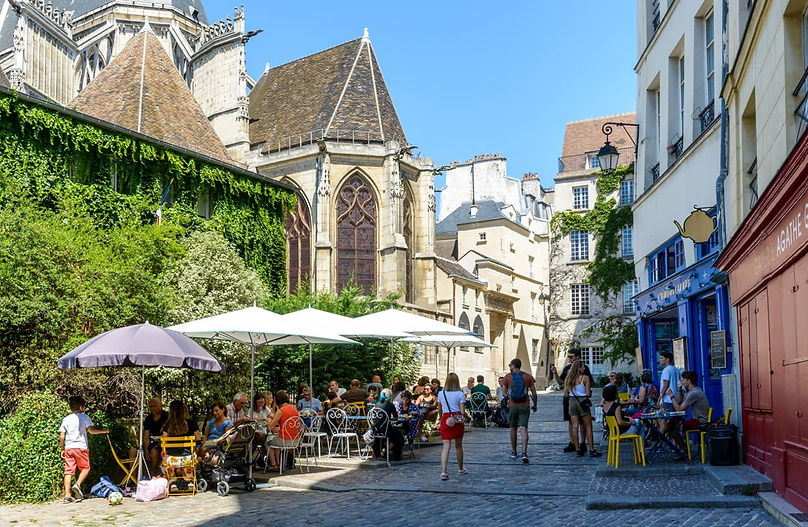
Le Marais
The history of the Marais district of Paris is rich and captivating, filled with famous people, anecdotes and key moments in the city's history. It's the story of a neighborhood that has had its ups and downs, but is now one of the hippest and liveliest neighborhoods in the city.
His history...
At first, the Marais was a marshland that extended outside the city walls. Over time, locals began to drain and cultivate it, and it became a residential area for aristocrats. Imposing mansions and private gardens were built, reflecting the wealth and power of their owners.
One of these mansions was the House of Nicolas Flamel, a famous 15th century alchemist. Legend has it that Flamel discovered the secret of the philosopher's stone, which would transform lead into gold. Although this story is probably false, it gave rise to a myriad of tales and legends that have spanned the centuries.
The Marais was also the scene of many important events in French history. During the French Revolution, rioters organized barricades there and fought the royal forces. Later, in the 19th century, the Marais became a popular neighborhood for artists and writers, who found inspiration for their work there.
Unfortunately, during the 20th century, the Marais experienced a period of decline and deterioration. Buildings were abandoned and streets were overrun with crime. However, in the 1970s, a renovation movement began, and the Marais is today one of the most dynamic and trendy neighborhoods in Paris.
Today, the Marais is home to numerous museums, art galleries, trendy boutiques and restaurants, as well as numerous historic buildings and peaceful public gardens. It is a neighborhood that continues to evolve and adapt to the times, while keeping its rich historical heritage alive.
It is therefore the story of a district in constant evolution, a district which has experienced moments of glory and moments of decline...
A short tour of the great classics of the Marais district...
-
Place des Vosges: begin your visit by admiring the oldest paved square in Paris, surrounded by arcaded houses from the 17th century.
-
Musée Carnavalet: visit this museum dedicated to the history of Paris and discover how the Marais was once the district of aristocrats.
-
Place des Frigos: admire this old refrigeration factory transformed into art galleries.
-
Saint-Paul Saint-Louis Church: visit this baroque church built in the 17th century.
-
Rue des Rosiers: stroll along this shopping street in the Marais, known for its many Jewish restaurants.
-
European House of Photography: visit this art gallery dedicated to photography.
-
Place de la Bastille: admire this square famous for its historic past and lively nightlife.
-
Notre-Dame-de-Nazareth Church: visit this Gothic church built in the 19th century.
































An eye on urban planning
The Marais district is characterized by dense and historic urban planning. The area retains a large number of old buildings, narrow streets and interior courtyards, giving it a unique charm and making it one of the most popular areas of Paris.
However, the urban planning of the Marais has undergone significant transformations in recent decades. For example, in the 1960s and 1970s, several buildings were destroyed to make way for modern office and housing buildings. More recently, the neighborhood has been the scene of several urban redevelopment projects, aimed in particular at improving circulation and pedestrian accessibility.
Among these projects, we can cite:
-
The redevelopment of Place de la République, located on the northwest edge of the Marais. This square was completely redesigned in the 2010s to better accommodate pedestrians and cyclists.
-
The pedestrianization of rue des Francs-Bourgeois, one of the main arteries of the Marais. This street was closed to automobile traffic in 2016, creating a busy pedestrian promenade.
-
In March 2022, Paris Mayor Anne Hidalgo announced her intention to transform the Town Hall in the 4th arrondissement into a museum of the history of Paris. This proposal sparked debate among residents and local elected officials.
-
In November 2021, Paris City Hall announced plans to redevelop Place de la Bastille, which is located on the northeastern edge of the Marais. This project includes the creation of a large 2-hectare park on the site of the former Bastille station.
-
In 2020, the Marais was one of the districts of Paris most affected by the Covid-19 crisis, due to its high concentration of shops and tourist places. Since then, local authorities have put in place measures to help local businesses overcome the crisis.
The gentrification of the Marais is also a source of debate and concern for certain residents and associations. Some believe that the gentrification of the neighborhood has led to an increase in real estate prices and a homogenization of the population, to the detriment of cultural and social diversity.
A short tour of the most original, most unusual places...
-
The Museum of Arts and Crafts: this scientific and technical museum offers a fascinating collection of inventions and machines, some of which are very old.
-
La Samaritaine: this former department store is now abandoned, but its impressive architecture makes it an unusual place to visit.
-
The Center Pompidou: this modern art museum houses an exceptional collection of works of art, as well as surprising temporary exhibitions.
-
Le Jardin de l'Arsenal: this tranquil garden is hidden behind the ramparts of the citadel and offers a view of the Seine.
-
The Catacombs: This macabre site is accessible via a spiral staircase and houses the remains of millions of Parisians.

